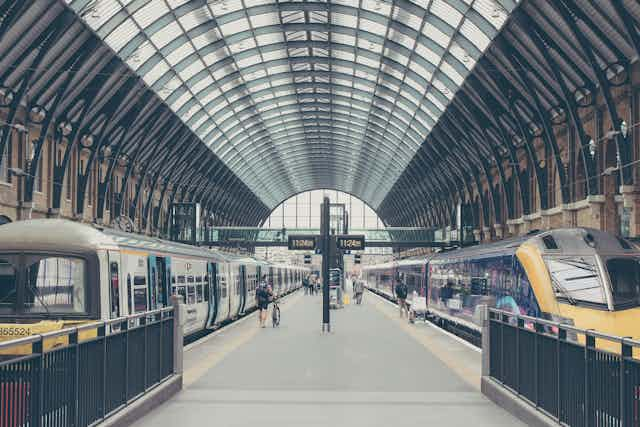Just who exactly supports the UK’s privatised railway industry? It’s certainly not passengers, taxpayers, railway employees or increasingly many politicians.
The state-owned British Rail was privatised over several years starting in 1995. Prime Minister Margaret Thatcher was politically astute enough to avoid privatising this industry. But her successor, John Major, had no such doubts – he was convinced privatisation would ensure “greater responsiveness to the customer, and a higher quality of service and better value for money”. He couldn’t have been more wrong. It’s now time to call a halt on this misconceived and misguided experiment – it just isn’t working. It’s time to renationalise the whole industry.
The benefits of privatisation forecast by politicians never materialised. Fares are now much higher, infrastructure failures and train delays increasing, the train franchising system is floundering and passenger dissatisfaction is high.
British Rail, the former nationalised industry, was a fully vertically integrated industry. This meant that BR owned and was responsible for virtually every aspect of the railway business. One researcher found it to be “perhaps the most financially successful railway in Europe”. Government subsidy was only 15% of revenue in 1994, making British Rail the least subsidised railway system in Europe at the time.
Privatisation saw the industry broken up into over 100 separate companies. This fragmentation has led to a complex contractual web of operational transactions between different industry players – with a profit mark up being extracted at every stage. Renationalisating the railways would put an end to the operational and structural absurdity of the industry – and be substantially less costly.
Dysfunctional franchise model
Passenger train operating companies are awarded on a franchised basis. Normally, the operators bid to pay the highest premium to the government to win the right to operate train services on specified routes. This is based on the revenue each bidding company considers they can extract from passengers after paying their premium.
Renationalisation would lead to abolition of the costly and dysfunctional method of awarding these franchises. It would abolish the convoluted gaming by operating companies, who frequently overbid on the most optimistic assumptions in order to win a franchise.
Take the example of the failing East Coast franchise. GNER and National Express have both already walked away from their East Coast commitments and Virgin East Coast is currently renegotiating its franchise. They can do this because the penalties for failing to deliver are too low.
What’s more, the whole costly and time-consuming refranchising process is repeated every seven or eight years. Renationalisation would bring a swift halt to this disruptive and costly process – and permit better long-term planning.
Fares through the roof
Certainly, the passenger hasn’t benefited by lower fares since privatisation. Only about 36% of fare revenue is regulated by the government and, even then, fare increases are related to the higher retail price index (RPI) measure of inflation (and not the lower consumer price index). For unregulated fares, the train operators have not been slow to increase fare revenue well in excess of RPI. For example, across all operators, standard class unregulated fares have increased by nearly 30% in real terms since privatisation.
Whenever the train operators have the freedom to raise fares they rarely fail to increase them to whatever the market can bear. The Trades Union Congress recently highlighted that British commuters are now “spending up to five times as much of their salary on season tickets” than their continental counterparts. A commuter season ticket in the UK costing £381 a month will cost the equivalent of £66 in France or £118 in Germany.
Neglected and costly infrastructure
Another key aspect of the privatised industry is the infrastructure company that owns the railway tracks, stations and signalling. The first infrastructure company, Railtrack plc, was a publicly listed company that had a short life. Within less than five years of floatation the came the fatal Hatfield rail crash, when an express train came off the track. An inquiry found that the disaster was directly related to Railtrack’s neglect of the infrastructure.

Railtrack’s successor, Network Rail, ultimately became a public sector body of the Department for Transport. But Network Rail has been hampered by Railtrack’s former neglect of its assets and higher costs resulting from the fragmented nature of the industry. Indeed, these issues meant that the McNulty report in 2011, commissioned by the then transport secretary, found the privatised rail industry had a high cost base and the costs per passenger-km would have to be reduced by 40% to match railways in France, Netherlands, Sweden and Switzerland.
Misguided support
Even the taxpayer would benefit from renationalisation. Under privatisation, state subsidies have nearly doubled in real terms. Direct government support has also previously been given to private sector train operators if their revenues fall below expectations. More recent franchisees can now receive these corporate state welfare “top-up” payments where, for example, there is fall in GDP or a slowdown in the London jobs market. Conventional private sector companies carry these business risks themselves – not so for the train companies. Renationalisation could reduce subsidies and have major financial gains for the tax payer.
Industry players frequently justify the success of privatisation by pointing to the growth in passenger traffic (passenger journeys have grown from 800m in 1996-97 to 1,729m in 2016-17). But this growth is despite privatisation; not because of it. Economic studies suggest this is down to other factors, such as employment levels, growth in GDP, property prices, leisure travel and road congestion – but not to privatisation.
Overall, railway privatisation has failed to achieve its original objectives. Fares and state subsidies remain high, passengers are failing to obtain better value for money and industry unit costs remain stubbornly high. No other country has fully adopted the UK model of railway privatisation. And for good reason – it hasn’t worked.

